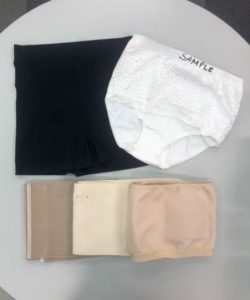Following your surgery, your Stomal Therapy Nurse will help you to decide which stoma products best suit your needs and lifestyle. As you progress at home you will soon discover that there are many different types of stoma bags available, such as one-piece systems, two-piece systems, convex appliances, cut to fit appliances, pre-cut appliances, mouldable appliances etc. You will also learn that there are many different types of accessories available to assist with stoma care such as seals, pastes, powders, barrier wipes, adhesive remover wipes, deodorants, creams and hernia support garments. Not all stoma products and accessories are suitable to use in all situations though so it is important that you seek the advice of your Stomal Therapy Nurse or Medical Practitioner before adding a new product to your stoma care routine.
The type of pouch closure most appropriate for your use will usually be determined by your stoma type. Generally speaking, a person with a colostomy will use a closed end pouch, a person with an ileostomy will use an open ended pouch to allow for regular content draining, and a person with a urostomy (or ileal conduit) will use a pouch with a tap or plug closure. In some cases though consistency and regularity of output may be such that a person with a colostomy will find a drainable pouch to be more appropriate or a person with an ileostomy may find that a closed end pouch better suits their situation.
The Stoma Appliance Scheme schedule is a list of those products available to eligible persons registered for the Stoma Appliance Scheme, including maximum monthly and annual allowances. Most Stoma Appliance Scheme (SAS) ostomy product supply companies offer a free sampling service but you should always consult your Stomal Therapy Nurse or Medical Practitioner for advice before changing to a new product.
The two piece pouching system
In a two-piece system, the ostomy pouch and skin barrier are separate items.The skin Barrier (wafer, back plate) is fitted first then the pouch (bag) is fitted to the landing area of the wafer. The method of attachment to the wafer varies between brands and product ranges but may be either a press-on/click “Tupperware” type coupling, or a “sticky” adhesive coupling. The two-piece arrangement allows pouches to be exchanged without removing the wafer.
A two-piece system is made up of:
- Pouch — bag that collects stool or urine
- The skin barrier which has an adhesive back and a hole in the centre. The skin barrier attaches to the abdomen to protect the skin. Some skin barriers include a tape border to help hold the barrier in place. The skin barrier may be a cut to fit, precut or mouldable (able to be moulded to the correct size and shape using fingers) product. The skin barrier can be flat or convex.
- Flange — plastic ring on both the pouch and skin barrier that provides a secure attachment. To work, the flanges must be of the same size and same product family.
Two piece systems are available with closed ends, drainable ends, or tap/plug ends.

The one piece pouching system
In a one-piece system, the ostomy pouch and skin barrier are joined together as one complete product.
The one piece products consists of :
- The pouch or bag that collects stool or urine.
- The skin barrier which has an adhesive back and a hole in the centre. The skin barrier attaches to the abdomen to protect the skin. Some skin barriers include a tape border to help hold the barrier in place. The skin barrier may be a cut to fit, precut or mouldable (able to be moulded to the correct size and shape using fingers) product. The skin barrier can be flat or convex.
One piece systems are available with closed ends, drainable ends, or tap/plug ends.
Through the Stoma Appliance Scheme, ostomy patients can access a range of ostomy accessories which are designed to improve stoma care outcomes. Following is an introduction to some of the more common accessories available. Remember though…before introducing an accessory to your stoma care routine, it is important to seek the guidance of a Stomal Therapy Nurse or GP as not all accessories suit all situations and “more” may not necessarily be best!
Stoma paste is designed to fill in the cavities, crevices, dips and folds around the stoma to provide a smooth surface.This gives an ideal base to ensure that the flange adheres safely and securely to the skin, thus minimising the potential of a leak.
The paste is easily applied to dry skin using a moistened finger to shape and to obtain a smooth surface. Paste should be allowed to set for 30 seconds before applying the base plate.
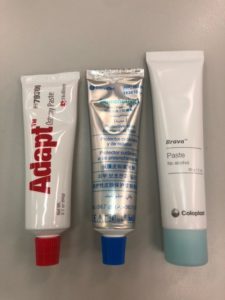
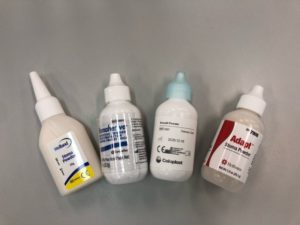
Protective powder is a powdered hydrocolloid which protects damaged, raw or sore parastomal skin and can help to dry broken, weeping skin. Powders specifically made for the skin around a stoma will not hamper adhesion of the appliance and may help damaged skin to heal more quickly.
Stoma seals are designed to reduce leakage by improving the seal around the stoma. Some seals add a convexity to a flat pouch, some are “cohesive”, and some are mouldable and have a memory. Stoma Seals are available in a variety of sizes, shapes and thicknesses.
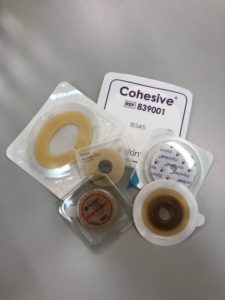
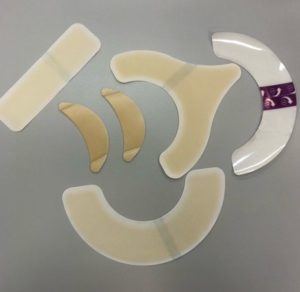
Flange extenders offer additional security to an appliance by providing a reliable and effective way to secure a pouch and to prevent leaks.
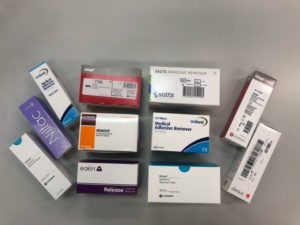
Adhesive removers remove excess or ‘sticky’ adhesive from skin and are available as an aerosol spray or wipe. When using an adhesive remover, care should be taken to ensure that it is washed off the skin as residual traces of remover may affect adhesion of the base plate.
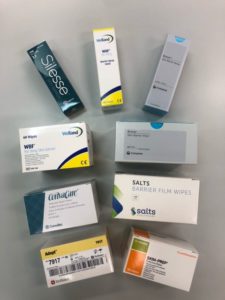
Barrier products may be applied to peristomal skin to protect it against damage from the constant application and removal of appliance adhesives, friction, digestive juices, faecal and urinary waste matter. Barrier products are gently applied to the skin, creating a thin, uniform, waterproof layer, like a second skin over the entire area. The film should be allowed to dry thoroughly before the ostomy pouching system is fitted.
Care should be taken not to overuse skin barrier products as a build-up of barrier product on the skin may affect adhesion of the base plate.
Lubricating deodorants reduce ‘pancaking’ and odour. The deodorant is formulated to breakdown odours rather than to mask them with another scent. The lubricant reduces static, and thus the likelihood of the plastic sides of the pouch sticking together.
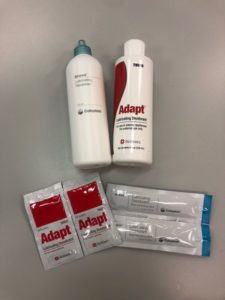
Ostomy deodorants are made specifically to absorb odour in stoma appliances. Deodorants can be used before and after emptying a pouch.
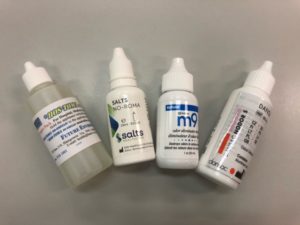
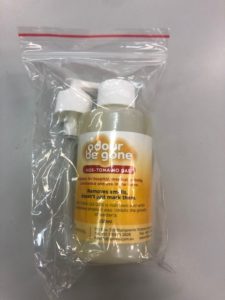
The objective of a gas suppressant is to reduce pouch ballooning and increase pouch filter life by significantly reducing or eliminating gas and odour in the ostomy pouch.
Thickening agents are designed to turn a liquid stool into a more manageable solid stool. These are ideal for those persons who have a liquid/high output stoma. When placed in a pouch, this product absorbs all fluids within seconds by turning the pouch contents into a gel, thus minimising odour, noise and the potential for leakage. Thickening agents allow emptying and cleaning of the pouch to be managed more easily.
Special authorisation is required to be obtained from a Stomal therapy Nurse or GP for gelling sachet use.
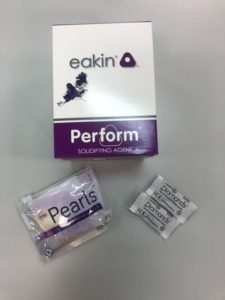
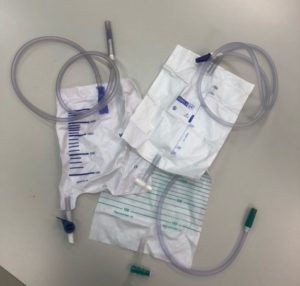
A night drainage bag increases the capacity of the appliance for a person with a urostomy or ileal conduit.
A Hernia Support Garment is an accessory used to either prevent or support a parastomal hernia. The garment can be either a belt, or a pair of boxers or briefs with a supportive band.
